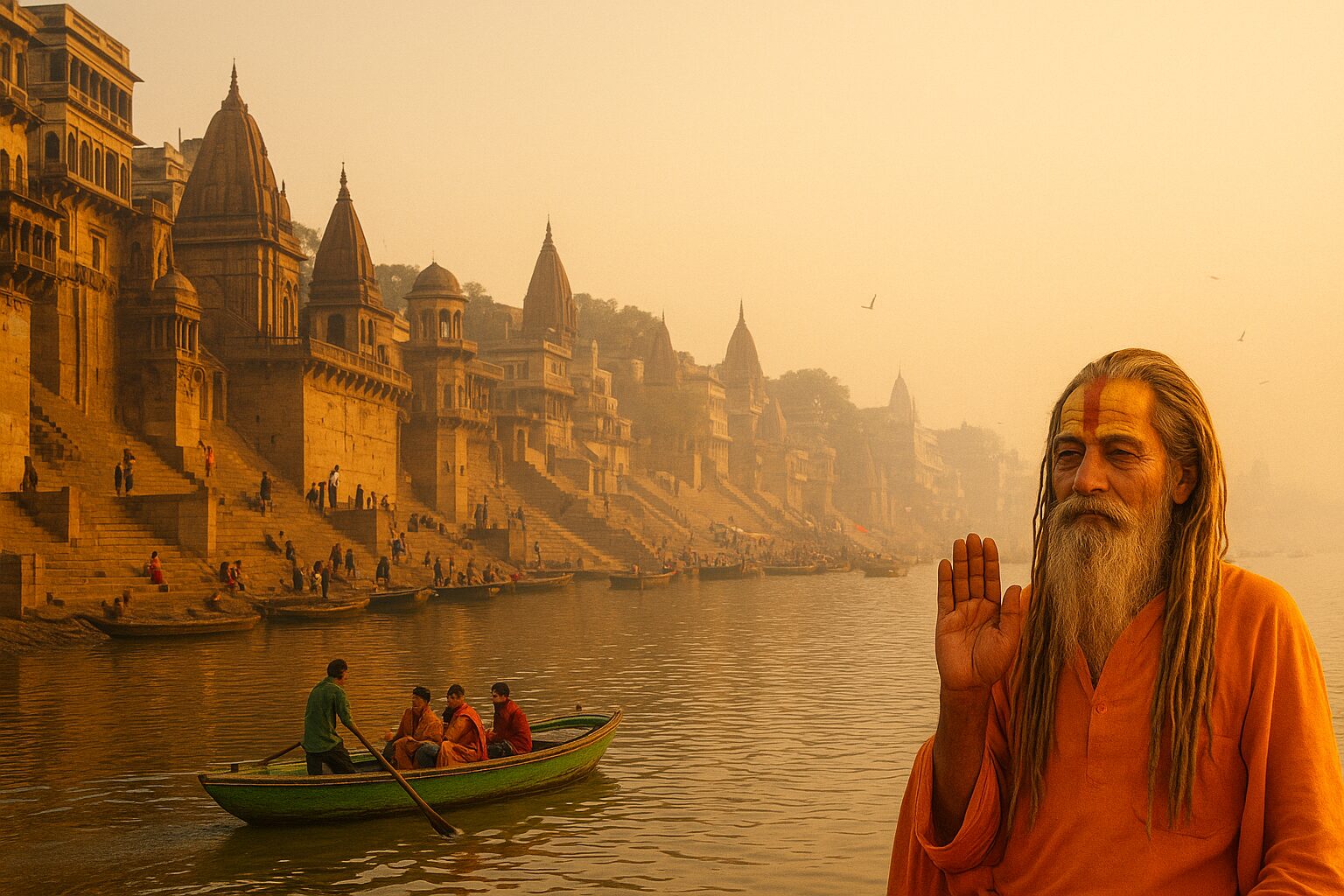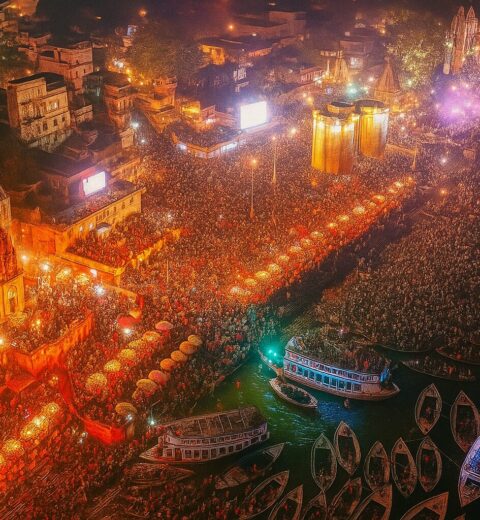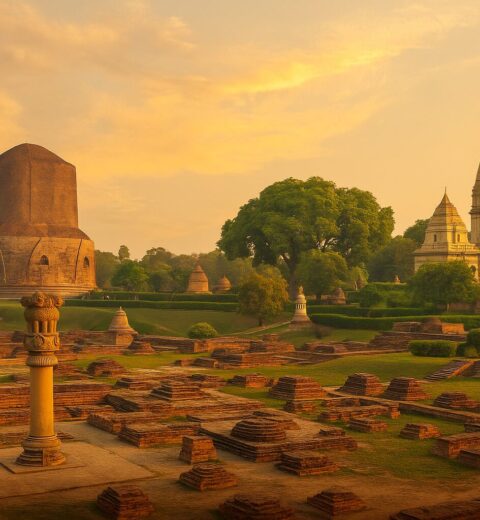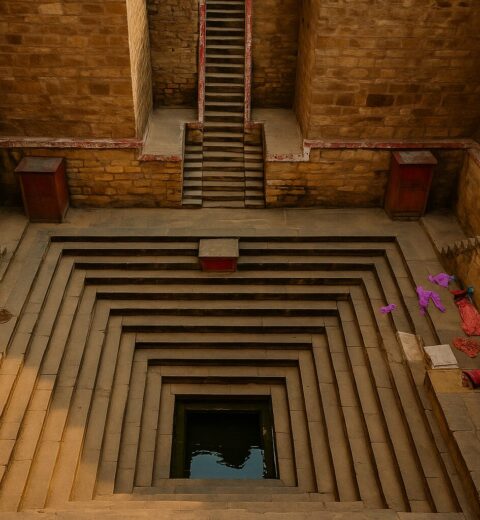Why Banaras is a Paradise for Photographers
Banaras — or Varanasi — is not just a city. It’s a living canvas where time stands still, light dances over the sacred Ganga, and stories unfold with every step. For photographers, both seasoned and aspiring, Banaras offers something truly unmatched: raw, timeless emotion captured in frames steeped in culture, chaos, silence, and soul.
In Banaras, the mundane becomes magnificent. A wrinkled sadhu draped in orange, lost in prayer beside the Ganga. A child feeding pigeons on a foggy ghat. A woman lighting a diya in the twilight. These aren’t scenes staged for the camera — they’re daily rhythms of a city that lives in devotion. As a photographer, you’re not just capturing moments, but centuries-old rituals and the pulse of life itself.
Banaras is blessed with some of the most magical light in India. The golden glow of sunrise on Assi Ghat, the moody haze of Manikarnika Ghat, the surreal blues of the evening Ganga Aarti — every hour transforms the same locations into new visual experiences. The colorful sarees, painted doors, saffron-clad priests, aging stone steps, and marigold offerings all create layers of color and contrast that beg to be captured.
Where else can you find meditative stillness amidst one of the busiest cities in the world? The city’s organized chaos — narrow lanes echoing with temple bells, crowded ghats brimming with life — strangely offers photographers a perfect storm of energy and calm. It’s a place where slow shutters catch smoky rituals, and fast frames freeze a monkey’s leap over a rooftop shrine.
Unlike most photogenic cities, Banaras isn’t only about aesthetic beauty. It’s about meaning. Every ritual has a reason, every frame carries history. Whether it’s the ash-smeared Aghori or the weaver crafting Banarasi silk in a dimly lit room — your lens doesn’t just see, it feels. The city invites deeper storytelling: portraits with purpose, details with depth, and light with legacy.
Perfect for Every Photography Genre
Whether you’re into:
- Street Photography — capture gallis, chai stalls, pilgrims, and parades
- Portraits — sadhus, artisans, children, and everyday Banarasis
- Architecture — temples, havelis, crumbling facades, and ghats
- Documentary — festival rituals, akharas, spiritual practices
- Fine Art — shadows, abstract frames, long exposures on water
Banaras gives you more than material. It gives you meaning.
Best Times of the Day to Capture Varanasi
Light is everything in photography — and in Banaras, light doesn’t just illuminate; it transforms. The city wears different moods with the sun’s movement, offering unique photographic opportunities at every hour. Whether you’re shooting at dawn’s hush or twilight’s spiritual crescendo, timing your shoot can make the difference between a good frame and a breathtaking one.
Golden Hour – Sunrise at Assi Ghat (5:30 AM – 7:00 AM)
Mornings in Varanasi are sacred. As the first light hits the Ganga, a soft golden hue washes over the river, the ghats, the boats, and the early risers. Assi Ghat is the epicenter of this visual and spiritual awakening, especially during the Subah-e-Banaras program — a morning cultural ritual with live classical music and yoga.
What to capture:
- Sunlight hitting the Ganga and the rising smoke from incense
- Reflections of boats and temples in calm water
- Locals and travelers doing yoga, meditating, or taking a holy dip
- Monkeys, birds, and dogs — the city’s early morning residents
Tips:
- Use a tripod for the early light and slower shutter speeds
- A wide-angle lens works beautifully for river panoramas
- Arrive by 5:00 AM to settle in before the crowd and catch the full light transition
Mid-Morning Glow (8:00 AM – 10:00 AM)
As the city warms up, the streets come alive. The soft shadows of early morning give way to high contrast scenes — perfect for black-and-white street photography or tight portrait work. The gallis near Kashi Vishwanath Temple and Chowk area are great for storytelling frames full of color, chaos, and character.
What to capture:
- Rickshaw pullers, shopkeepers, chaiwallahs, priests
- Textures of crumbling walls, doors, and paan-stained staircases
- Artisans weaving Banarasi silk or crafting wooden toys
High Noon Hues (12:00 PM – 2:00 PM)
This is often the harshest light of the day, but also the most architecturally revealing. The shadows are deep, the light is crisp, and details in structures become prominent. Explore temples, rooftops, and forts at this hour — especially places like Ramnagar Fort, where the play of light and shadow creates dramatic frames.
Tips:
- Use polarizing filters to cut glare and deepen the sky
- Ideal time for detail shots or symmetry-based frames
- Avoid portraits unless you find shaded spots or use reflectors
Golden Hour – Evening near Dashashwamedh Ghat (4:30 PM – 6:30 PM)
As the day winds down, the magic returns. The river glows again in softer light, the ghats bustle with pilgrims, and anticipation builds for the Ganga Aarti. This time is ideal for candid portraits, street rituals, and the play of shadows in gallis and ghat steps.
What to capture:
- Devotees lighting lamps, priests preparing for Aarti
- Cows, sadhus, and street musicians
- Reflections in water, backlit silhouettes of boats
Blue Hour & Ganga Aarti (6:30 PM – 7:30 PM)
No trip to Banaras is complete without photographing the Ganga Aarti — a visual and spiritual spectacle. As the sky turns blue and the first flames rise from priestly hands, the atmosphere becomes otherworldly. Shooting during this hour requires a blend of patience and technique.
Tips:
- Use a fast lens (f/1.8 or lower) for low light
- Try handheld shots at higher ISOs or use monopods/tripods from boats
- Long exposure shots of fire trails and diyas floating on the river are stunning
Night Shots (Post 8 PM)
Even after the rituals end, Banaras doesn’t sleep. Some ghats go quiet and become moody, while others — like Manikarnika — burn through the night. The silence, the shadows, and the minimal ambient light allow for moody, cinematic photography.
What to capture:
- Long exposure shots of the river under moonlight
- Abstracts — silhouettes, shadows, reflections
- A quiet chai stall or an elderly figure walking the ghat alone
Light by Season
- Winter: Misty mornings, golden afternoons (ideal for ethereal street shots)
- Monsoon: Moody skies, wet textures, dramatic cloudscapes
- Summer: Hazy light, harsh shadows — excellent for contrasts and black-and-white
Top 15 Photography Locations in Varanasi
Varanasi is an ever-evolving film reel — each corner of the city tells a story, each frame soaked in layers of spirituality, decay, tradition, and movement. From bustling ghats and smoky cremation rituals to forgotten alleyways and rooftop vistas, these 15 handpicked locations are must-visits for any photographer looking to frame the soul of Banaras.
1. Assi Ghat (Sunrise & Subah-e-Banaras)
- Ideal for golden hour photography
- Captures yoga sessions, musicians, bathers, and boat reflections
- Best for wide-angle shots and silhouettes
2. Dashashwamedh Ghat (Ganga Aarti)
- Grand evening ritual with fire, chants, and crowd energy
- Shoot from the steps or from a boat for symmetrical compositions
- Use fast lenses or try long-exposure shots for fire trails
3. Manikarnika Ghat (From a Distance)
- One of the oldest cremation grounds in the world
- Approach with respect — best to shoot from a respectful distance or a boat
- Emotive black-and-white frames, smoky atmosphere
4. Tulsi Ghat & Akhada
- Early morning visits reveal wrestlers at the akhada
- Ideal for motion shots, portraits, and textures
- Above the ghat lies Tulsi Smarak, steeped in literary history
5. Lolark Kund
- Ancient sun-worship tank with surreal symmetry
- Best visited in the early morning light for mirror-like reflections
- Capture religious rituals, monks, and old stone textures
6. Chowk Area (Old City Bazaars)
- Vibrant street life — colorful shops, weavers, pilgrims, cows, and chaos
- Perfect for candid street photography and environmental portraits
- Use a 35mm or 50mm prime lens for storytelling shots
7. Kashi Vishwanath Galli
- Narrow alleys leading to the temple with colorful graffiti, saffron flags, and temples
- Ideal for documenting daily life, processions, and spontaneous moments
- Works well for moody, layered compositions
8. Ramnagar Fort
- Across the river; known for its courtyards, museum, and ornate balconies
- Shoot royal architecture, shadow play, and riverside views of the city
- Visit during festivals like Dussehra for added vibrance
9. Panchganga Ghat
- Less crowded, very atmospheric in the mornings
- Known for ancient temples and spiritual serenity
- Capture storytelling frames of silent rituals and boatmen
10. Sarnath (Buddhist Ruins & Stupa)
- Great for architectural photography, minimalism, and contrast
- Explore the Dhamek Stupa, Ashokan Pillar, and serene Bodhi tree areas
- Use soft morning light or late afternoon for warm tones
11. Bengali Tola & Rooftops
- Overlook the ghats and river from elevated angles
- Capture the linear geometry of ghat steps and people’s movement
- Great spot for wide panoramas and aerial-feel shots
12. Kabir Chaura
- Cultural hub known for musicians, dancers, and mystics
- Perfect for portraits with character and stories behind them
- Explore hidden lanes, music schools, and spiritual akharas
13. Alamgir Mosque (Gyanvapi Mosque)
- A Mughal structure perched at the edge of Panchganga Ghat
- Known for its imposing minarets and river-facing terrace
- Early mornings are ideal for architectural frames
14. Doors & Havelis of Vishwanath Galli & Nai Sarak
- Old, paint-peeled doors with symbolic carvings and locks
- Use shallow depth-of-field for artistic frames
- Ideal for niche architecture and texture series
15. Street Corners & Chai Stalls
- Some of the best moments in Banaras happen in small nooks
- Document daily life: paanwalas, tea brewers, devotees, musicians
- Keep your camera ready and be discreet for natural expressions
Create a custom photography trail map combining these locations by time of day or theme (e.g., ghats in the morning, old city by noon, aarti in the evening). Offer it as a downloadable PDF or lead magnet on your website.
Portraits and People: Faces of Banaras
If ghats are the bones of Banaras, its people are the beating heart. Their faces — wrinkled with wisdom, softened with devotion, or lit with joy — tell stories that no architecture ever could. For photographers, Banaras offers endless human expressions that speak of a city that breathes spirituality, tradition, and resilience. But photographing people in Varanasi isn’t just about clicking — it’s about connecting.
- Sadhus and monks draped in saffron robes, often deep in meditation or caught mid-chant
- Boatmen steering with strength and serenity through morning fog
- Artisans and weavers bent over looms, their fingers telling generational stories
- Street vendors, chaiwalas, and flower sellers radiating color and character
- Children playing on ghat steps or dancing around cows and goats
Every face you see in Banaras has depth. Some are open, inviting lenses. Others carry centuries of stories behind their eyes. Your camera must approach them with empathy.
How to Approach Portrait Subjects Respectfully
- Start with a Smile or a Conversation
Don’t just lift your camera. Say “Namaste”, buy chai, or ask about their day. Most Banarasis appreciate genuine interest. - Seek Permission
A nod, smile, or even a wordless gesture can show consent. Respect their response if they decline. - Offer Prints (or Show the Shot)
If you have a portable printer or plan to revisit, offer to bring back their photo. Or simply show it to them — it creates trust. - Avoid Intrusion in Intimate or Sacred Moments
Especially during cremation rituals, personal prayers, or mourning — observe, don’t intrude. - Tip or Support Locals
If someone makes time for you (like a sadhu posing intentionally), offer a small donation or buy something from their stall.
Tips for Capturing Powerful Portraits
- Use natural light — diffused morning or evening sun works best.
- Focus on the eyes — they carry the emotion of the frame.
- Get close, but respectfully — 35mm or 50mm lenses offer intimacy without distortion.
- Use shadows and backgrounds — the ghats, gallis, or smoke create moody backdrops.
- Shoot at f/1.8–2.8 for shallow depth — isolate your subject from the bustling background.
Series Ideas for Portrait Projects in Banaras
- “Faces of Faith”: Portraits of sadhus, pujaris, nuns, and devotees
- “Hands of Banaras”: Close-ups of craftsmen, weavers, boatmen at work
- “Banaras Bazaar”: Shopkeepers, vendors, chaiwalas in their colorful chaos
- “Banaras Kids”: Candid childhood on the ghats and gallis
Ethical Photography in Banaras
Portraiture in Varanasi is powerful, but also sensitive. Many locals don’t mind being clicked — in fact, some take pride in it. But always remember:
- You’re entering someone’s spiritual space
- What you click today may end up online tomorrow — so be mindful of dignity, especially with elders, women, and mourning individuals
What to Pack: Gear, Lenses, and Essentials for Photography in Banaras
Photographing Varanasi is both an artistic and logistical challenge. From dusty lanes to boat rides, and from early morning fog to low-light rituals, the city demands both creative readiness and practical preparedness. Whether you’re carrying a DSLR, a mirrorless setup, or even a smartphone — being equipped with the right tools (and mindset) can help you make the most of your photography experience.
Camera Gear Essentials
Camera Body
- Any DSLR or mirrorless body that handles low light and high ISO well is ideal.
- Full-frame cameras work beautifully for dynamic range, but crop sensors can work great too — especially for street and travel shots.
Lens Recommendations
- 24–70mm: The perfect all-rounder for street, portraits, ghats, and temples.
- 35mm or 50mm prime: Excellent for street photography and intimate portraits.
- 85mm: Beautiful for portraits and capturing people from a respectful distance.
- 16–35mm wide-angle: Ideal for landscapes, ghats, and architecture.
- 70–200mm (if carrying): For distant subjects like Ganga Aarti from a boat or candid street portraits from afar.
Accessories You Shouldn’t Forget
- ND Filter: Useful for long exposures during daylight (e.g. river scenes, moving people).
- Polarizing Filter: Helps cut reflection from water and deepens sky contrast — excellent during midday.
- Tripod or Monopod: Useful for early mornings, low light during Ganga Aarti, and long exposure photography.
- Camera Rain Cover / Dry Bag: A must during monsoon or near ghats to protect gear from water splashes or sudden rain.
- Portable Lens Cleaning Kit: Banaras can be dusty — keep a blower and cloth handy.
- Spare Batteries and SD Cards: Long shooting days and no time to recharge — always carry extra.
- Lightweight Camera Bag: Choose something with back support and easy-access side zips.
For Mobile Photographers
- Carry a gimbal for video or long exposure time lapses.
- Use apps like Snapseed, Lightroom Mobile, or VSCO for on-the-go editing.
- Clip-on wide-angle or macro lenses can expand your smartphone’s potential.
- Power bank is essential — photo and video drain battery quickly.
Personal Comfort + Field Essentials
- Good Walking Shoes: You’ll walk for hours across ghats, steps, and uneven gallis.
- Sunscreen, Hat & Sunglasses: Especially in the harsh sun of late mornings and afternoons.
- Refillable Water Bottle: Stay hydrated while shooting long hours.
- Snacks & Electrolytes: For days when you’re out from sunrise to sunset.
Safety & Practical Tips
- Keep gear close in crowded areas — use a cross-body bag or anti-theft design.
- In cremation zones (Manikarnika, Harishchandra Ghats), avoid using large lenses or intrusive gear. Photography here should be done from afar or not at all.
- Ask locals before photographing sensitive or personal moments.
Keep your gear minimal, but powerful. Over-packing will tire you out. Prioritize what you’ll actually use based on your day’s trail: if you’re shooting ghats and portraits, 1 camera + 2 lenses + phone is more than enough.
Festivals You Shouldn’t Miss (for Photographers)
The Varanasi Photographer’s Festival Calendar
If there’s one thing more photogenic than daily life in Banaras, it’s the festive life. Rituals steeped in symbolism, thousands of diyas lighting up the ghats, the raw power of devotion, and the chaos of processions — festivals in Varanasi offer once-in-a-lifetime frames. For photographers, these events are not just colorful — they are emotionally and visually charged experiences where every corner of the city becomes a stage.
Here are the top festivals every lens-lover should mark on their calendar:
Dev Deepawali (November) – The Festival of a Thousand Lamps
- What to Expect: The ghats glow with millions of diyas as locals decorate the steps of the Ganga.
- Why Photograph: Perfect for wide-angle long exposures, light trails, drone shots (if permitted), and silhouettes.
- Tips:
- Reach early to get your vantage point.
- A tripod and fast lens are a must.
- Best captured from boats for a panoramic view of the illuminated ghats.
Mahashivratri (Feb–March) – The Night of Shiva
- What to Expect: Barefoot processions, ash-smeared sadhus, and night-long prayers.
- Why Photograph: High-energy rituals at Kashi Vishwanath Temple, powerful portraits of Naga sadhus, temple lights.
- Tips:
- Be prepared for dense crowds.
- Shoot from side streets or rooftops for overhead shots.
Holi (March) – The Festival of Colors
- What to Expect: A riot of colors across temples, streets, and ghats.
- Why Photograph: Candid joy, powder explosions, and expressive faces.
- Tips:
- Use waterproof housing for cameras or a GoPro.
- Protect your lens with a UV filter.
- Eye-level, wide shots are most dramatic.
Ganga Dussehra (May–June) – Celebrating the Descent of the Ganga
- What to Expect: Devotees take mass dips in the Ganga. Priests perform elaborate rituals.
- Why Photograph: Great for aerial-style wide shots of the river, devotional close-ups, and boat scenes.
- Tips:
- Use early morning light for softness.
- Respect personal space at riverbanks.
Bharat Milap (October) – Ram Leela’s Grand Finale
- What to Expect: The symbolic reunion of Ram and Bharat post-exile, enacted with a city-wide procession.
- Why Photograph: Grand costumes, street parades, emotional drama, historical reenactments.
- Tips:
- Use a telephoto lens for detailed expressions.
- Focus on character interactions for story-telling frames.
Nag Nathaiya (November) – Krishna Leela on the Ganga
- What to Expect: A dramatic enactment of Lord Krishna jumping into the Yamuna (Ganga here) to fight Kaliya Naag, played by a young boy diving from a tree into the river.
- Why Photograph: One of the most visually spectacular scenes in Banaras.
- Tips:
- Use burst mode to capture the mid-air dive.
- Arrive at Tulsi Ghat early; space fills up fast.
Shitala Mata Mahotsav (March) – Music & Devotion Combined
- What to Expect: Held at Badi Shitala Mata Dham, this 5-day music festival blends devotion and classical music.
- Why Photograph: Unique low-light indoor stage photography, expressions of artists, bhajan groups, devotees.
- Tips:
- Use a fast prime lens and shoot during evening performances.
- Combine portraits with crowd and emotion shots.
Monthly Rituals
- Purnima Nights (Full Moon) — Ghats look magical in moonlight. Ideal for long exposure riverscapes.
- Morning Ragas at Assi Ghat — Ongoing year-round during Subah-e-Banaras. Blend classical music and yoga frames.
Suggested Photography Trails (Self-Guided Routes in Banaras)
Follow the Light. Follow the Life.
Banaras is not a city to photograph randomly — it’s a city to experience through movement. With every step along the ghats or inside the labyrinthine gallis, you shift between centuries, moods, and moments. To help photographers plan their day with intention, we’ve created three self-guided trails based on time, light, and subject.
Each trail offers a structured flow of locations with the best time to shoot, what to look for, and the kind of gear you’ll need.
Trail 1: “Spiritual Morning Walk” — Golden Hour on the Ghats
Time: 5:30 AM – 9:00 AM
Ideal For: Landscapes, rituals, candid portraits, boats, foggy atmosphere
Route:
- Assi Ghat (sunrise, yoga, Subah-e-Banaras program)
- Tulsi Ghat (mud wrestling at Akhara)
- Lolark Kund (sacred tank + morning rituals)
- Walking north along ghats: capture bathers, priests, chai vendors
- Dashashwamedh Ghat (post-sunrise activity, crowd building)
Tips:
- Carry wide-angle + 50mm prime lens
- Use ND filter if experimenting with long exposure on water
- Watch how the light changes every 20 minutes — it’s magical
Trail 2: “Ghats to God” — The Ritual and Chaos Trail
Time: 3:00 PM – 7:30 PM
Ideal For: Faces, crowds, ritual details, Ganga Aarti, sunset
Route:
- Man Mandir Ghat (early golden light + sandstone textures)
- Panchganga Ghat (less crowded, spiritual ambience)
- Walk through Vishwanath Galli (shops, portraits, temple pilgrims)
- Dashashwamedh Ghat (pre-Aarti energy and ambient light)
- Ganga Aarti (from boat or rooftop — dramatic fire-lit visuals)
Tips:
- Use fast lenses (f/1.8 or lower) for twilight and Aarti
- Get your boat spot booked before 5:30 PM
- Shoot candid interactions between pilgrims and priests
Trail 3: “Old City Texture Trail” — Streets, Doors & Culture
Time: 10:00 AM – 1:00 PM (good overhead light for textures)
Ideal For: Architecture, street life, candid moments, abstract frames
Route:
- Kabir Chaura (cultural centers, old homes, music schools)
- Chowk Area (bazaars, cows, shopkeepers, rickshaw scenes)
- Nai Sarak & Thatheri Bazar (metalwork, utensil sellers)
- Doors of Vishwanath Galli (peeling paint, door knockers, shadows)
- Hidden Rooftops of Bengali Tola (look for access with permission — great for wide shots)
Tips:
Great time to capture color + decay + detail
Switch between 35mm and macro/prime lenses
Use high shutter speed in bright light, embrace shadows
Want a Curated Photo Tour? We’ve Got One!
Capture Banaras Like Never Before — With a Local by Your Side
Exploring Varanasi with a camera is unforgettable. But exploring it with someone who knows its hidden angles, lighting windows, respectful entry points, and compelling human stories? That’s transformative.
That’s what our Explore Banaras Photography Walks are designed for — whether you’re a solo traveler with a DSLR, a street enthusiast with a smartphone, or a creative couple on a visual retreat.
What Makes Our Photo Tours Special
- Local Insight, Photographer’s Eye
Our guides aren’t just locals — they understand light, angles, and the kind of moments you’re chasing. - Pre-Curated Routes Based on Light & Mood
Choose from:- Sunrise Ghats & Morning Rituals
- Twilight & Aarti Glow Trails
- Old City Textures & People Stories
- Festival & Ritual Immersive Walks (on select dates)
- Flexible Timing Based on Golden Hours
We begin our walks when the light is right — not just when it’s convenient. - Culturally Respectful Approach
We ensure you capture the essence of Banaras without intrusion. We guide you on when to shoot, when to pause, and how to connect before clicking.
What You Get
- A 2–4 hour guided trail
- Tips on framing, composition, and etiquette
- Time to explore independently with backup support
- Complimentary tea stop at a local favourite
- Optional photo critique session (on request)
- Rental camera or tripod support available (advance request)
Who It’s For
- Solo photographers and digital nomads
- Couples seeking meaningful travel experiences
- Content creators, bloggers, and vloggers
- Curious travelers with an eye for beauty
How to Book
You can:
- Check our Photography Tours Page (Coming Soon)
- Message us directly through our Instagram or WhatsApp
- Or simply ask your host at our homestay to arrange one
We keep our groups small and personalised, so early booking is always better!
Bonus Add-On:
We offer sunrise-to-sunset custom photo day-outs — explore ghats, gallis, rooftops, and rituals across one immersive day with meals, boat rides, and chai breaks woven in.
“You won’t just return with memory cards full of photos. You’ll return with stories — waiting to be told.”





